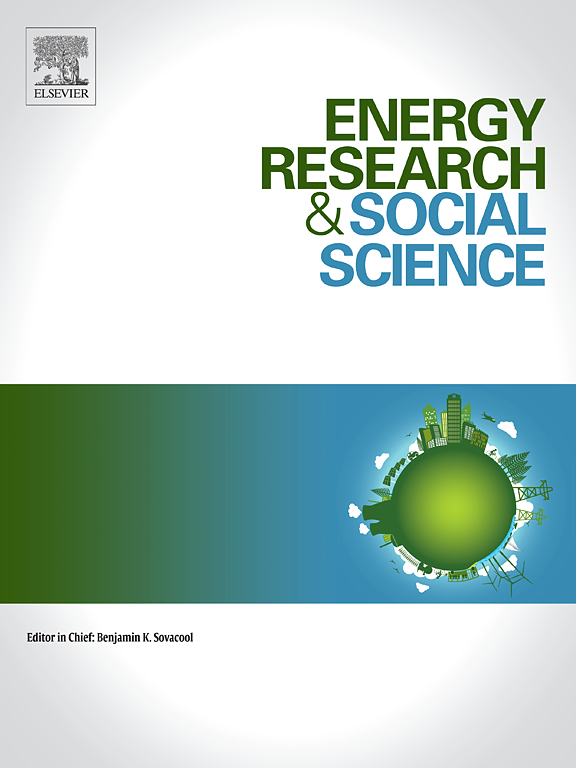沟通孤岛:海上风电规划和许可流程的治理网络方法
IF 7.4
2区 经济学
Q1 ENVIRONMENTAL STUDIES
引用次数: 0
摘要
要实现各国的能源政策目标,就海上风能和其他新能源基础设施进行有效沟通是必要的。这也是一个独特的挑战,特别是在美国,考虑到发展的早期阶段和多层次,多方面的海上风能治理环境。本文将沟通方法应用于海上风能治理网络,以评估网络属性如何影响美国东北部两个海上风电开发项目的沟通动态和挑战。我们采用社会网络分析和主题分析来表征和分析网络结构以及有影响力和缺失的参与者,以了解影响这些项目规划和许可的沟通模式。整个网络的结果显示了低密度、分散的结构,这说明了网络的笨拙和通信真空问题的专题分析结果。该网络由一个核心和多个外围集群组成,这些集群由部门、地理位置和/或态度形成;专题分析结果支持了这一点,即社区被孤立在孤岛中。最有影响力的参与者是两个项目开发商和主要的审批机构。然而,专题分析结果表明,它们可能没有发挥桥梁作用或促进信息流动。缺失的行为者包括部落,影响力较低的部门包括地方政府、渔民、利益相关者团体和科学组织。网络的笨拙可能解释了利益相关者的孤立和与关键选区的有限接触。结果为研究和实践提供了多种建议。本文章由计算机程序翻译,如有差异,请以英文原文为准。
Communication silos: A governance network approach to the offshore wind planning and permitting process
Effective communication about offshore wind and other new energy infrastructure is necessary to achieve nations' energy policy goals. It is also uniquely challenging, particularly in the United States, given the early stage of development and the multi-layered, multi-faceted offshore wind energy governance context. This paper applied a communication approach to the offshore wind energy governance network to assess how network attributes shape communication dynamics and challenges for two offshore wind developments in the northeastern U.S. We employed social network analysis and thematic analysis to characterize and analyze network structure and influential and missing actors, in order to understand communication patterns shaping these projects' planning and permitting. Whole network results revealed a low-density, decentralized structure, which elucidates thematic analysis findings of the network's unwieldiness and a communication vacuum problem. The network comprises one core and multiple peripheral clusters shaped by sector, geography and/or attitudes; this is supported by thematic analysis findings that communities are isolated in silos. The most influential actors were the two project developers and the lead permitting agency. However, thematic analysis results suggest they may not be performing bridging functions or facilitating information flow. Missing actors included Tribes, and sectors with lower influence included local governments, fishers, stakeholder groups, and scientific organizations. The network's unwieldiness may explain stakeholder isolation and limited engagement with key constituencies. Results inform multiple recommendations for research and practice.
求助全文
通过发布文献求助,成功后即可免费获取论文全文。
去求助
来源期刊

Energy Research & Social Science
ENVIRONMENTAL STUDIES-
CiteScore
14.00
自引率
16.40%
发文量
441
审稿时长
55 days
期刊介绍:
Energy Research & Social Science (ERSS) is a peer-reviewed international journal that publishes original research and review articles examining the relationship between energy systems and society. ERSS covers a range of topics revolving around the intersection of energy technologies, fuels, and resources on one side and social processes and influences - including communities of energy users, people affected by energy production, social institutions, customs, traditions, behaviors, and policies - on the other. Put another way, ERSS investigates the social system surrounding energy technology and hardware. ERSS is relevant for energy practitioners, researchers interested in the social aspects of energy production or use, and policymakers.
Energy Research & Social Science (ERSS) provides an interdisciplinary forum to discuss how social and technical issues related to energy production and consumption interact. Energy production, distribution, and consumption all have both technical and human components, and the latter involves the human causes and consequences of energy-related activities and processes as well as social structures that shape how people interact with energy systems. Energy analysis, therefore, needs to look beyond the dimensions of technology and economics to include these social and human elements.
 求助内容:
求助内容: 应助结果提醒方式:
应助结果提醒方式:


